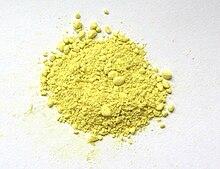 | |
 | |
| Clinical data | |
|---|---|
| Routes of administration | Oral |
| ATC code |
|
| Identifiers | |
| |
| CAS Number | |
| PubChem CID | |
| ChemSpider | |
| UNII | |
| KEGG | |
| ChEBI | |
| ChEMBL | |
| CompTox Dashboard (EPA) | |
| ECHA InfoCard | 100.014.371 |
| Chemical and physical data | |
| Formula | C21H22O9 |
| Molar mass | 418.398 g·mol−1 |
| 3D model (JSmol) | |
| Melting point | 148 °C (298 °F) (70–80 °C for monohydrate) |
| |
| |
| | |
Aloin, also known as barbaloin,[1] is a bitter, yellow-brown colored compound noted in the exudate of at least 68 Aloe species at levels from 0.1 to 6.6% of leaf dry weight (making between 3% and 35% of the total exudate),[2] and in another 17 species at indeterminate levels [Reynolds, 1995b]. It is used as a stimulant-laxative, treating constipation by inducing bowel movements.[3] The compound is present in what is commonly referred to as the aloe latex that exudes from cells adjacent to the vascular bundles, found under the rind of the leaf and in between it and the gel. When dried, it has been used as a bittering agent in commerce (alcoholic beverages) [21 CFR 172.510. Scientific names given include Aloe perryi, A. barbadensis (= A. vera), A. ferox, and hybrids of A. ferox with A. africana and A. spicata.]. Aloe is listed in federal regulations as a natural substance that may be "safely used in food" when used "in the minimum quantity required to produce their intended physical or technical effect and in accordance with all the principles of good manufacturing practice." This food application is generally limited to use in quite small quantities as a flavoring in alcoholic beverages and may usually be identified only as a "natural flavor."
In May 2002, the U.S. Food and Drug Administration (FDA) issued a ruling that aloe laxatives are no longer generally recognized as safe (GRAS) and effective, meaning that aloin-containing products are no longer available in over-the-counter drug products in the United States, because they may be carcinogenic and more data is needed to establish otherwise.[4] Aloe vera leaf latex is a concentrate of an herb or other botanical, and so meets the statutory description of an ingredient that may be used in dietary supplements.
- ^ Reynolds T (January 2004). "Analytical Methodology: the Exudate". In Reynolds T (ed.). Aloes: the genus Aloe. CRC Press. p. 128. ISBN 978-0-203-47634-5.
- ^ Groom QJ, Reynolds T (August 1987). "Barbaloin in aloe species". Planta Medica. 53 (4): 345–348. doi:10.1055/s-2006-962735. PMID 17269040. S2CID 36296239.
- ^ The Merck Index (12th ed.). p. 314.
- ^ "FDA docket Sec. 310.545 (a)(12)(iv)(c)". U.S. Food and Drug Administration.